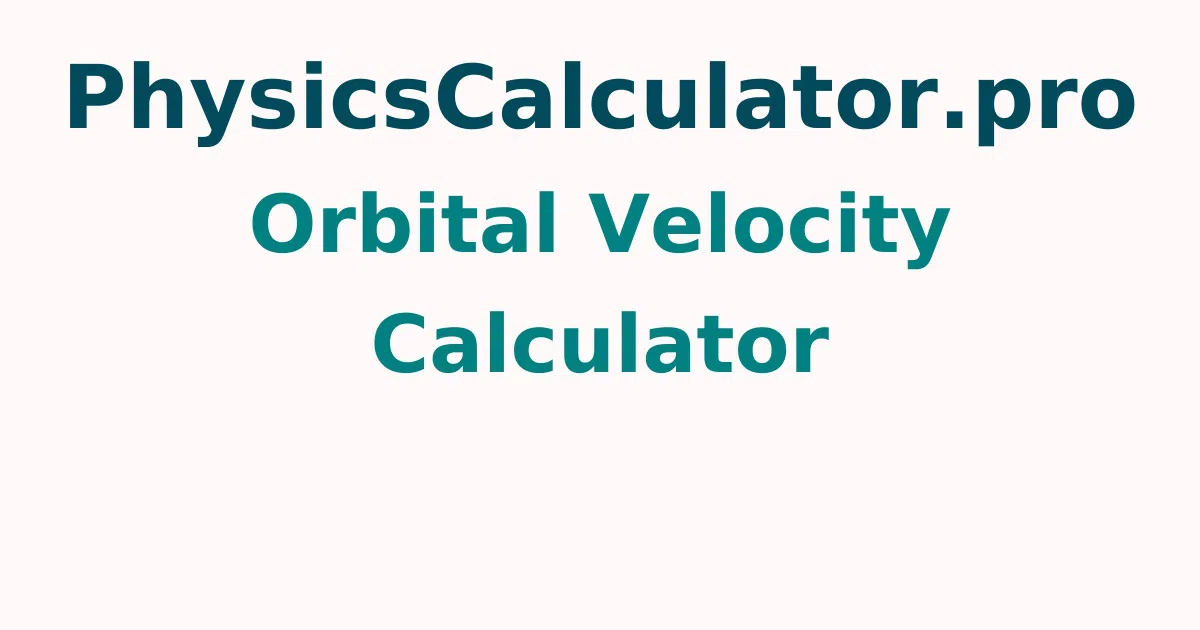Orbital Velocity Calculator
This Orbital Velocity calculator simply calculates eccentricity, orbital energy, radius, and speed of planets using semi-major axis, semi-minor axis, start mass, satellite mass, period, and distance information.
What is an Elliptical Orbit?
It is related to the other two key parameters: semi-major axis and semi-minor axis with the eccentricity formula is e = √(1 - b2/a2).
Ve = [2GM/R]V
- where, The eccentricity is denoted as e
- The semi-major axis is denoted as a
- The semi-minor axis is denoted as b
- We can calculate periapsis and apoapsis
Periapsis:The closest possible distance of the satellite (planet) to a star.
Apoapsis: The farthest possible distance of the satellite (planet) to a star using the given parameters.
With the following elliptical orbit definition, we may estimate distances to a star at periapsis and apoapsis:
ra+rp = 2*a
ra*rp = b2
- where, ra is the distance between the star and the satellite in apoapsis
- rp is the distance between the star and the satellite in periapsis
You can checkout more concept with physicscalculatorpro.com to get quick answers by using this free tool.
Orbital Velocity Formula
The speed at which one body spins around another is known as orbital velocity. Objects in orbit are those that travel in a consistent circular motion around the Earth. The distance between the object and the earth's centre determines the orbit's velocity.
This velocity is frequently assigned to artificial satellites in order for them to rotate around a specific planet.
The formula for orbital velocity is as follows: Vorbit = √GM/R
Where,
- G stands for gravitational constant
- M is the mass of the body at its centre
- R is the orbit's radius
If mass M and radius R are known, the Orbital Velocity Formula is used to compute the orbital velocity of any planet.
The unit of the orbital velocity is measured in metre per second (m/s).
Equations of Vis-viva Or Orbital Velocity
We can model the motion of orbiting satellites using the vis-viva equation. It calculates a satellite orbital speed at any point on an elliptic orbit, as well as its orbital velocity in periapsis and apoapsis.The following is the vis-viva equation:
V2 = μ*(2/r-1/a)
- Here, v be the relative satellite speed
- μ be the standard gravitational parameter μ = G(M + m)
- The gravitational constant and it is denoted by G and the value is 6.674 x 10-11 N-m2/kg2.
- M is the mass of the star
- The mass of the satellite denoted as m
- r is the distance between the star and the satellite
- a is the semi-major axis of the elliptical orbit
You may calculate the satellite speed at apoapsis (r = ra) and periapsis (r = rp) using the orbital speed formula above.
Kepler Laws | Orbital Radius of Earth
You calculate orbital period of planets that can be derived from the Kepler laws of planetary motion:
The law of orbits is Kepler's first law: Every planet in the Solar System follows an elliptical orbit around the Sun.
The law of areas is Kepler's second law: A line segment between a planet and the Sun sweeps out equal portions at equal intervals (area speed is constant).
The law of periods is Kepler's third law. By comparing the centripetal force to the gravitational force, you may get the simplified form of Kepler's third law. The complete equivalent formula is as follows:
T2=4*π2*a3/μ
- Here, T be the orbital period of a satellite
- To determine the orbital energy of planets by the following formula is E=-G*M*m/(2*a).
- Planets have a negative total orbital energy that is independent of the ellipse's eccentricity.
Orbital Velocity Examples
Question 1: Find the orbital eccentricity whose semi-major and semi-minor axis are 100m and 50m.
Solution:
Consider the problem, we have
Semi-major axis, a = 100m
Semi-minor axis, b = 50m
The formula for finding the Eccentricity, e = √(1 – b2/a2)
e = 0.8660254037844386
e = 0.87
Therefore,the orbital eccentricity is 0.8660254037844386
FAQs on Orbital Velocity Calculator
1. What does orbital velocity imply?
The speed necessary to achieve orbit around a celestial body, such as a planet or a star, is known as orbital velocity. This necessitates travelling at a constant speed that: Aligns with the rotational velocity of the celestial object.
2. Is orbital velocity and orbital speed the same factor?
The distance between the item and the Earth's centre determines the orbit's velocity. The velocity must be just correct such that the distance to the Earth's centre remains constant. As a result, orbital speed is a crucial calculation.
3. What is the earth and satellite orbital velocity?
The Earth's orbital velocity is 29.78 kilometres per second. A satellite's orbital velocity is 17,000 metres per hour.
4. Define orbital velocity and Its formula.
The speed at which one body spins around another is known as orbital velocity. Objects in orbit are those that travel in a consistent circular motion around the Earth. The distance between the object and the earth's centre determines the orbit's velocity.
The formula for orbital velocity is as follows:Vorbit = √GM / R.
5. What is the required velocity to remain in orbit?
A satellite must travel at an extremely high velocity, which varies depending on its height, to stay in orbit. A speed of 7.8 km/s (28,000 km/h) is required for a circular orbit at a height of 300 km above the Earth's surface. The spacecraft will complete one orbit around the Earth in 90 minutes at current speed.
